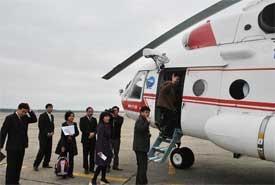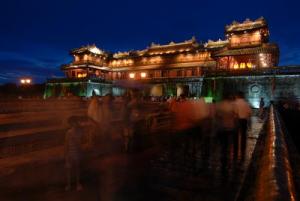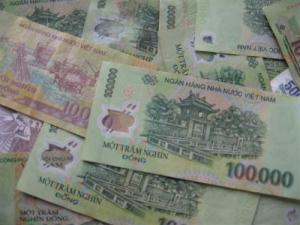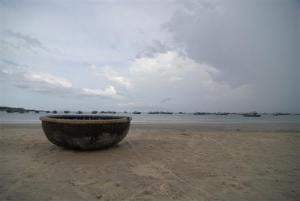My Son, near Hoi An
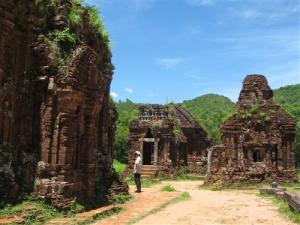
70km southwest of Danang City and 40km away from the Ancient Town of Hoi An, a large complex of religious relics that comprises more than 70 architectural works is a popular destination for those who appreciate architecture, history and pure spectacle. Known as My Son (Vietnamese: Mỹ Sơn), the group of temple-towers that connect to each other with complicated red brick designs is a proud display of the evolution of Vietnam’s culture and a foremost evidence of Asian civilization which is now extinct. My Son Sanctuary is a large complex of religious relics, of which, the main component of the Cham architectural design is the tower, built to reflect the divinity of the king. It is located in a narrow valley in Duy Tan Commune, Duy Xuyen District of Quang Nam Province. It nestles in a town found at the end of a bumpy road through tropical jungle.
The beautifully carved stone sculptures and the ruins of old buildings reveal mysteries up to 1500 years old. As one of the religious center and capital of the ancient Champa Kingdom, it is a significantly sacred site. It emerged during the 2nd century in the area around Danang. Through commercial and religious associations with India, the Champa kingdom quickly developed a strong affinity for Indian culture, borrowing Hinduism and the Sanskrit alphabet, as well as Indian architectural and artistic tastes. According to records on the stone stele, the prime foundation of the ancient My Son architectural complex was a wooden temple to worship the Shiva Bhadresvera genie. In the late 16th century, a big fire destroyed the temple but was rebuilt.
Aside from religious celebrations, which allowed the dynastic royals to spiritually connect with the gods, My Son was also the political capital, a cultural centre and was the burial place for Cham monarchs. For many centuries the Champa kingdom existed as an independent entity, warring constantly with the Vietnamese to the north and the Khmer to the west. The kingdom endured until the 17th century when it was absorbed by Vietnam. Most of the temples were dedicated to Cham kings associated with divinities, particularly Shiva, who was regarded as the founder and protector of Champa’s dynasties.
Treasures within a Treasure
The Vietnam-American War caused the region to be completely devastated and depopulated. American bombs have reduced many of the towers to ruins, but they failed to destroy about 20 of them. Thus, there’s still plenty to see. In fact, Vietnam has better preserved Cham sites on other parts of the country. But probably why My Son remains to be the most popular is because of the remarkably beautiful surroundings where it is nestled in – a verdant valley surrounded by hills and overlooked by Cat’s Tooth Mountain (known Hon Quap). Clear streams also run between the structures and past nearby coffee plantations.
Standing in the middle of this sanctuary, tourists will have the chance to better understand the ancient Champa Kingdom and its architectural works. The site was constructed by the King of Champa between 4th and 12th centuries for worship. The remains of sculptural and architectural remnants from the war are masterpieces that mark a glorious time for the architecture and sculpture of the Cham as well as Southeast Asia.
These ruins represent a series of constructions over many centuries. Judging from the surviving structures, the Champa kingdom were predominately Hindu, and Shivaist at that. In the temple cities of My Son lies lingams that symbolizes both the cult of Shivaism and also of the divine authority of kingship. Each historical period has its own identity, so that each temple worshipping a genie or a king of a different kingdom has its own architectural style full of different impression.
Each period of history, a particular architecture would be observed. Generally, the Champa temple towers were built on hills, a strategic site to survey the surrounding area. Principally, however, these locations were chosen because they were regarded as the focus of magic powers, especially suitable for meditation and religious observance.
Getting there
When leaving from Hanoi, tourists board a train to Danang station, and from there, take a bus or a car to My Son. February to April is known to be the best time to plan trip to My Son since rainfall is not plentiful and the temperature is comfortable. Upon reaching My Son, a brief visit to the museum before visiting the temples would make the trip much more worth it.
Hiring a car costs around USD$20, quite a lot pricey compared to taking the bus or mini-bus which is just less than $5. However, the option of hiring a car allows one to take the trip in his own pace, take as many occasional stops for photos, breathers or choose to get there ahead of everyone.
Bus or minibus rides to My Son can be organized by travel agencies or even the hotel where you are booked. Only, you have to be there at the set time, of which most trips depart at 8am and return at 1pm. A day trip includes a stop-off at Tra Kieu. At less than $5, it sure is an incredible deal.
There are travel agencies that offer land trip to My Son, but allow them the option of returning by boat. That adds a couple of extra hours to the trip. It would cost a couple of extra dollars as well, but the views make the extra hours and cost so much worth it.
Plan your next Trip
My Son is considered to be a smaller version of other preserved Champa civilizations like the Angkor in Cambodia, Ayu-thaya of Thailand, Bagan of Myanmar and Borobudur in Java. But the complete package of mystical towers surrounded by breathtaking views makes it extremely popular for sightseeing in Vietnam for both foreign and domestic tourists.
You can take a little preview of what you will encounter at My Son by coming by the Cham Architecture Museum in Danang. After the My Son ancient tower complex was discovered, many of its artifacts, especially statues of female dancers and genies worshipped by the Cham people, worship animals and artifacts of the daily communal activities, were collected and displayed there.
Today, Vietnamese authorities are attempting to restore as much as possible of the remaining sites. The beauty of My Son would be more complete if not for the destruction caused by the decades-old war. But it holds so much historical and cultural value, for which, the complex was recognized as a World Heritage Site by UNESCO in December 1999. Indeed, there may not be so many remnants left like its bigger counterparts in its neighboring countries, but those that remain display the typical sculptural works of cultural value of the Cham nationality. Furthermore, they are vivid proof, confirming the history of a nationality living within the Vietnamese community boasting of a rich cultural tradition. Come and visit the My Son Sanctuary and discover the ancient Champa Kingdom.




